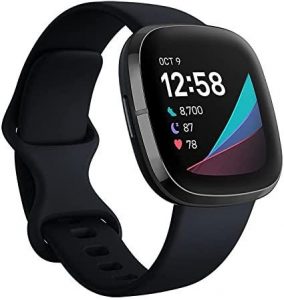Is Fitbit Sense a Useful Piece of Tech for Seniors?
Fitbits are generally associated with tracking your progress towards 10,000 steps daily, but Fitbits have now evolved to do a lot more. The confusing thing is that there are many different types of Fitbits, and while some do exactly that – mostly count steps and associated metrics such as active minutes with a few key health metrics such as heart rate, there are some Fitbit models with very advanced functions as well and can be of special use to seniors. Fitbit Sense is one of those devices.
While Fitbit works with both Android and Apple, it may be best for seniors using Android devices; as Apple Watches work so effortlessly with iPhones.

What is Fitbit Sense?
Fitbit Sense is a cutting-edge fitness tracker which resembles a smartwatch. It has an assortment of sensors and functionality such as EKG/ECG, SPO2, mindfulness scoring, and a very well-developed sleep scoring which Fitbit is especially known for.

Fitbit Sense Features:
The Sense has a beautiful design with multiple colors available and comes with a retina+ display. You can also take calls with ease using Bluetooth. It has a long battery life and can last more than 6 days. The only key feature that Fitbit Sense lacks today is Fall Detection. The Fitbit Sense retails for $199, which is a great price for the features that it can provide. It also has advanced features like EDA, breathing rate, skin temperature, and detailed sleep analysis which seem very useful but we only found a few of them (except sleep analysis) a bit esoteric, and perhaps only useful for seniors who are really into medical metrics.
Fitbit also provides a 6-month subscription to premium, which gives users access to premium content and added capabilities for historical trending.
What about other types of Fitbits?
We can’t just talk about Sense without acknowledging a myriad of other Fitbit models. The lineup is divided into Smartwatches such as Sense and trackers which are closer in shape to a band. The trackers have a very small watch face, and hence one can still wear a regular watch on the other hand while wearing a tracker. In the Smartwatch category, Fitbit also has the Versa line, which is a step down from the Sense. It provides SPO2 but not ECG/EKG.
In the tracker Category, Charge 5 is the most appropriate product for seniors as it has both the ECG/EKG and SPO2 for a retail of $149 as of today. The Luxe is a step down from Charge 5 with the omission of EKG/ECG, for just $20 less – we think that the $20 extra on the Charge 5 is well worth the money for seniors.
How easy to use is Sense for Seniors?
Setting up the Fitbit Sense and getting both EKG and Blood Oxygen levels to load correctly requires the use of additional apps or Clock Faces, which can be challenging for someone who is not very familiar with the Play Store and Android devices. However, once the setup is complete, the Fitbit Sense works like a charm.

Conclusion:
The Fitbit Sense is a device loaded with high-end functionality such as EKG and SPO2, given its price point of $199. It has great battery life, which allows a user to wear it for several days with a single charge. It is a bit more difficult to set up than an Apple Watch, but it’s a great option for Android phone users who can’t use an Apple Watch anyway. The only important feature it lacks compared to an Apple Watch is the Fall Detection feature, but this may not be essential for everyone.
More information and Setup Guide:
There is a ton of information available about features on Fitbit’s website www.fitbit.com and the setup processes on online sites such as Youtube. To see our own experience configuring Fitbit Sense, click on “Articles” on the top and download the Article related to Fitbit Sense Setup.
